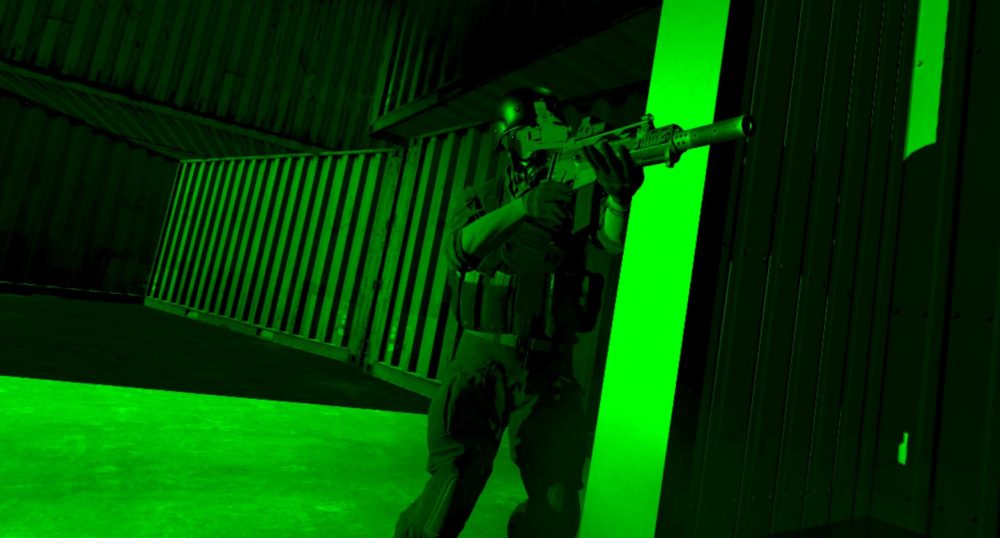I’ve killed a lot of people in virtual reality. Last night alone I wracked up well over 100 kills in just one experience called Pavlov VR. For each of my victims, I pulled out a gun, aimed for their heads, pulled the trigger and watched with satisfaction as their bodies jerked into lifelessness complete with low-poly blood spurts. Sometimes, if they managed to get too close, I even had to pull out a knife and slash them repeatedly. That’s a lot of violence.
With each kill my team’s score went up and each opponent I felled was instantly respawned for a chance to exact their own murderous revenge. Pavlov VR, Onward, and other games like them are quickly becoming the most popular VR games on the market. With VR shooters rising in popularity and prevalence a question must be asked: is it time to start considering the moral and psychological ramifications of shooting, attacking, and ultimately killing other humans inside a hyper-immersive VR headset?
Dante Buckley is the creator of the aforementioned Onward — arguably the most popular VR shooter available today. Buckley is a 20-year-old, self-taught game designer who built the entire game by himself. He is currently occupying a space in one of the world’s video game Meccas: the Valve offices in Redmond, Washington. UploadVR had the chance to speak with Buckley recently for a general interview and during our talk he expressed his growing concern with depictions of realistic violence in VR.
“Something that I’ve been thinking about lately is the ethics and the consciousness of violence in VR shooters,” Buckley said. “VR right now just doesn’t have enough power to create visuals that make you feel like what you’re doing in the game is real. It’s like you’re playing paint ball or like an advanced version of tag. But when things do start get more real for a game like Onward, or another first person shooter, there’s going to have to be a responsibility for people to consider.”
In Buckley’s mind, one way to address the issue as the fidelity of VR shooters improves would be to make the games more “casual” with a diminished focus on realism. This is somewhat surprising coming from the creator of a game like Onward. Right now, Onward’s main selling point is its realism. In this game when you die you’re dead for the rest of the match. There are no respawns, radars, or mini-maps. It’s just you, your team, and your gun. Despite the success that realism has brought to his game, Buckley says that he is prepared to take a different approach if there is no other way for the violence problem to be solved.
Video game purists have long turned up their nose at “violent video games create violent people” arguments, but it does seem that the debate should be given new light in the wake of such disruptive new hardware. VR games simply are not the same as 2D titles. The entire point of the technology is to make you feel immersed in your environment. Light needs to refract correctly, wind needs to blow with believable physics, and — in order to protect immersion — kills need to feel as realistic as possible.
As Buckley points out, right now no VR shooter is graphically powerful enough to truly make you believe that by shooting a digital enemy you’ve actually shot a living, breathing person. But that may not be the case for long. Upcoming VR games are already looking and playing better just a year after the hardware launched. Titles like Arktika.1 are jaw-droppingly beautiful, including the human enemies you’ll be shooting. What affects, if any, will this have on the human mind and spirit?
Arshya Vahabzadeh M.D. is the Chief Medical Officer at a VR startup called Brain Power and serves on the faculty at Harvard Medical School as a lecturer in psychiatry. We reached out to him to ask if a platform as immersive as VR could possibly cause people to contract real life psychiatric afflictions such as post traumatic stress disorder.
According to Dr. Vahabzadeh:
“Post traumatic stress disorder (PTSD) is commonly caused by a directly witnessed real life event that is life threatening or violent in nature. Current clinical diagnosis of PTSD excludes exposures that occur through electronic media, including movies and pictures.
However, given the immersive and interactive nature of VR, and the increasing ability to stimulate a range of senses beyond sight and sound, including tactile and olfactory sensations, one has to wonder if at some point these experiences may result in the rewiring the the brains fear centers in a similar way to that seen in PTSD.
One could postulate that if a person felt the VR experience was real, that they genuinely felt they were at risk of harm, and that they did not have a way of voluntarily ending the experience, they could experience rewiring of fear circuitry of their brain in a manner similar to PTSD. They would then perhaps have a range of PTSD like symptoms. Clearly this is an area that will need further research as immersive technologies become more realistic and widely used, and potentially abused.”
For now there seems to be a growing consensus from both medical professionals and VR game designers: violence in VR is not a problem…yet. But, as the industry matures so too should its understanding of the types of effects it can create and the scope of damage it might do.
What do you think? Does violence in VR concern you? Let us know in the comments below.






























